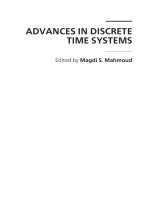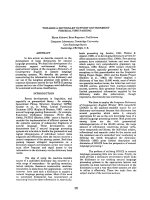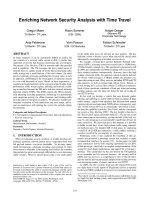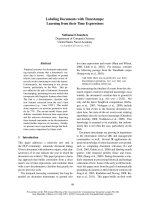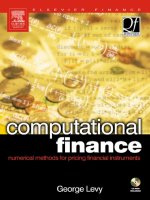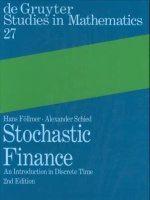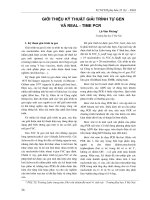Discrete Time Finance pot
Bạn đang xem bản rút gọn của tài liệu. Xem và tải ngay bản đầy đủ của tài liệu tại đây (418.52 KB, 104 trang )
Electronic copy of this paper is available at: />Discrete Time Finance
Dr. Christian-Oliver Ewald
School of Economics and Finance
University of St.Andrews
Electronic copy of this paper is available at: />Abstract
These are my Lecture Notes for a course in Discrete Time Finance
which I taught in the Winter term 2005 at the University of Leeds. I am
aware that the notes are not yet free of error and the manuscrip needs
further improvement. I am happy about any comment on the notes.
Please send your comments via e-mail to
Contents
1 Single Period Market Models 2
1.1 The most elementary Market Model . . . . . . . . . . . . 3
1.2 A general single period market model . . . . . . . . . . . 14
1.3 Single Period Consumption and Investment . . . . . . . . 37
1.4 Mean-Variance Analysis . . . . . . . . . . . . . . . . . . . 52
1.5 Exercises . . . . . . . . . . . . . . . . . . . . . . . . . . . . 65
2 Multi period Market Models 67
2.1 General Model Specifications . . . . . . . . . . . . . . . . 67
2.2 Properties of the general multi period market model . . . 77
2.3 The Binomial Asset Pricing Model . . . . . . . . . . . . . 89
2.4 Optimal Portfolios in a Multi Period market Model . . . . 97
1
Chapter 1
Single Period Market Models
Single period market models are the most elementary market models.
Only a single period is considered. The beginning of the period is usu-
ally denoted by the time t = 0 and the end of the period by time t = 1.
At time t = 0 stock prices, bond prices,possibly prices of other financial
assets or specific financial values are recorded and the financial agent
can choose his investment, often a portfolio of stocks and bond. At time
t = 1 prices are recorded again and the financial agent obtains a payoff
corresponding to the value of his portfolio at time t = 1. Single period
models are unrealistic in a way, that in reality trading takes place over
many periods, but they allow us to illustrate and understand many
of the important economic and mathematical principles in Financial
Mathematics without being mathematically to complex and challeng-
ing. We will later see, that more realistic multi period models can in-
deed be obtained by the concatenation of many single period models.
Single period models are therefore the building blocks of more compli-
cated models. In a way one can say :
Single period market models are the atoms of Financial
Mathematics.
Within this chapter, we assume that we have a finite sample space
Ω := {ω
1
, ω
2
, , ω
k
}.
2
We think of the samples ω
i
as possible states of the world at time t = 1.
The prices of the financial assets we are modeling in a single period
model, depend on the state of the world at time t = 1 and therefore
on the ω
i
’s. The exact state of world at time t = 1 is unknown at time
t = 0. We can not foresee the future. We assume however that we are
given information about the probabilities of the various states. More
precisely we assume that we have probability measure P on Ω with
P(ω) > 0 for all ω ∈ Ω. This probability measure represents the beliefs
of the agent. Different agents may have different beliefs and therefore
different P’s. However in the following we choose one agent who is in a
way a representative agent.
1.1 The most elementary Market Model
The most elementary but still interesting market model occurs when
we assume that Ω contains only two states. We denote these two states
by ω
1
= H and ω
2
= T . We think of the state at time t = 1 as determined
by the toss of a coin, which can result in Head or Tail,
Ω = {H, T }.
The result of the coin toss is not known at time t = 0 and is therefore
considered as random. We do not assume that the coin is a fair coin,
i.e. that H and T have the same probability, but that there is a number
0 < p < 1 s.t.
P(H) = p, P(T ) = 1 − p.
We consider a model, which consists of one stock and a money mar-
ket account. If we speak of one stock, we actually mean one type of
stock, for example Coca Cola, and agents can buy or sell arbitrary many
3
shares of this stock. For the money market account we think of a sav-
ings account. The money market account pays a deterministic ( non
random ) interest rate r > 0. This means that one pound invested into
the money market account at time t = 0 yields a return of 1 + r pounds
at time t = 1. The price of the stock at time t = 0 is known and denoted
by S
0
. The price of the stock at time t = 1 depends on the state of the
world and can therefore take the two values S
1
(H) and S
1
(T ), depend-
ing whether the coin toss results in H or T. It is not known at time t = 0
and therefore considered to be random. S
1
is a random variable, taking
the value S
1
(H) with probability p and the value S
1
(T ) with probability
1 − p. We define
u :=
S
1
(H)
S
0
, d :=
S
1
(T )
S
0
.
We assume that 0 < d < 1 < u. This means that the stock price can
either go up or down, but in any case remains positive. The stock can
then be represented by the following diagram :
S
0
u
S
0
p
88
1−p
&&
S
0
d
To complete our first market model we still need trading strategies.
The agents in this model are allowed to invest in the money market ac-
count and the stock. We represent such an investment by a pair (x, φ)
where x gives the total initial investment in pounds at time t = 0 and
φ denotes the numbers of shares bought at time t = 0. Given the in-
vestment strategy (x, φ), the agent then invests the remaining money
x −φS
0
in the money market account. We assume that φ can take any
possible value, i.e. φ ∈ R. This allows for example short selling as well
4
as taking arbitrary high credits. At the end of this section we will give
some remarks on the significance of these assumptions.
The value of the investment strategy (x, φ) at time t = 0 is clearly x,
the initial investment. The agent has to pay x pounds in order to buy
the trading strategy (x, φ). Within the period, meaning between time
t = 0 and time t = 1 the agent does nothing but waiting until time t = 1.
The value of the trading strategy at time t = 1 is given by its payoff.
The payoff however depends on the value of the stock at time t = 1 and
is therefore random. In fact it can take the two values :
V (x, φ)(H) = (x − φS
0
)(1 + r) + φS
1
(H)
if the coin toss results in H or
V (x, φ)(T ) = (x − φS
0
)(1 + r) + φS
1
(T )
if the coin toss results in T . We combine these two equations in the
following definition.
Definition 1.1.1. The value process of the trading strategy (x, φ) in
our elementary market model is given by (V
0
(x, φ), V
1
(x, φ)) where V
0
(x, φ) =
x and V
1
is the random variable
V
1
(x, φ) = (x − φS
0
)(1 + r) + φS
1
.
An essential feature of an efficient market is that if a trading strategy
can turn nothing into something, then it must also run the risk of loss.
Definition 1.1.2. An arbitrage is a trading strategy that begins with
no money, has zero probability of losing money, and has a positive prob-
ability of making money.
This definition is mathematically not precise. It does not refer to the
specific model we are using, but it gives the basic idea of an arbitrage
in words. A more mathematical definition is the following :
5
Definition 1.1.3. A trading strategy (x, φ) in our elementary market
model is called an arbitrage, if
1. x = V
0
(x, φ) = 0 (i.e. the trading strategy needs no initial invest-
ment)
2. V
1
(x, φ) ≥ 0 (i.e. there is no risk of losing money)
3. E(V
1
(x, φ)) = pV
1
(x, φ)(H) + (1 − p)V
1
(x, φ)(T ) > 0 (i.e. a strictly
positive payoff is expected).
A mathematical model that admits arbitrage cannot be used for anal-
ysis. Wealth can be generated from nothing in such a model. Real
markets sometimes exhibit arbitrage, but this is necessarily fleeting;
as soon as someone discovers it, trading takes actions that remove it.
We say that a model is arbitrage free, if there is no arbitrage in the
model. To rule out arbitrage in our elementary model we must assume
that d < 1 + r < u, otherwise we would have arbitrages in our model, as
wee will see now :
If d ≥ (1 + r), then the following strategy would be an arbitrage :
• begin with zero wealth and at time zero borrow S
0
from the money
market in order to buy one share of the stock.
Even in the worst case of a tail on the coin toss, i.e. S
1
= S
0
d, the stock
at time one will be worth S
0
d ≥ S
0
(1 + r), enough to pay off the money
market debt and the stock has a positive probability of being worth
strictly more since u > d > 1 + r, i.e. S
0
u > S
0
(1 + r).
If u ≤ 1 + r, then the following strategy is an arbitrage :
• sell one share of the stock short and invest the proceeds S
0
in the
money market
Even in the best case for the stock, i.e. S
1
= S
0
u the cost S
1
of replacing
it at time one will be less than or equal to the value S
0
(1 + r) of the
6
money market investment, and since d < u < 1 + r, there is a positive
probability that the cost of replacing the stock will be strictly less than
the value of the money market investment.
We have therefore shown :
No arbitrage ⇒ d < 1 + r < u.
The converse is also true :
d < 1 + r < u ⇒ No arbitrage.
The proof of this is left as Exercise 1. It will also follow from the coming
discussion in section 1.2. However, from this we get our first proposition
:
Proposition 1.1.1. The elementary single period market model dis-
cussed above is arbitrage free, if and only if d < 1 + r < u.
Certainly, stock price movements are much more complicated than in-
dicated by this elementary model. We consider it for the f ollowing two
reasons:
1. Within this model, the concept of arbitrage pricing and its relation
to risk-neutral pricing can be clearly illuminated.
2. A concatenation of many single period market models, gives a quite
realistic model, which is used in practice and provides a reasonably
good, computationally tractable approximation to continuous-time
models.
Let us now introduce another financial asset into our elementary mar-
ket model :
7
Definition 1.1.4. A European call option is a contract which gives
its buyer the right ( but not the obligation ) to buy a good at a future
time T for a price K. The good, the maturity time T and the strike price
K are specified in the contract.
We will consider such European call options in all of our financial mar-
ket models, which we are going to discuss in this lecture. European call
options are frequently traded on financial markets. A central question
will always be:
What price should such a European call option have ?
Within our elementary market model we do not have so many choices.
First, we assume that the good is the stock, and second that the ma-
turity time is T = 1, the end of the period. This is the only nontrivial
maturity time. The owner of a Eur opean call option can do the follow-
ing:
• if the stock price S
1
at time 1 is higher than K, buy the stock at time
t = 1 for the price K from the seller of the option and immediately
sell it on the market for the market price S
1
, leading to a profit of
S
1
− K
• if the stock price at time 1 is lower than K, then it doesn’t make
sense to buy the stock for the price K from the seller, if the agent
can buy it for a cheaper price on the market. In this case the agent
can also do simply nothing, leading to a payoff of 0.
This argumentation shows, that a European call option is equivalent to
an asset which has a payoff at time T = 1 of
max(S
1
− K, 0).
This payoff, is what the option is worth at time t = 1. Still the question
is, what is the option worth at time t = 0 ? We will answer this ques-
tion in the remaining part of this section, by applying the replication
8
principle. To do this, we consider more general an option, which is of
the type h(S
1
) where h : R → R is a function. Please note that since S
1
is random, h(S
1
) is also random. The European call option from above,
is then given by choosing the function h as h(x) := max(x −K, 0). There
are many other possible choices for h leading to different options. We
will discuss some of them in a later section. The replication principle
says the following :
Replication principle : If it is possible to find a trading
strategy which perfectly replicates the option, meaning that the
trading strategy guarantees exactly the same payoff as the option
at maturity time, then the price of this trading strategy must
coincide with the price of the option.
What would be, if the replication principle would not hold ? Assume
that the price of the option would be higher, than the price of a repli-
cating strategy. Then, with zero initial investment, one could sell the
option and buy the replicating strategy. Since one earns more from
selling the option than paying for the replication strategy, one has a
positive amount of money at hand at time t = 0. This money can then
be used to invest into the savings account ( or another riskless asset ).
At maturity, one may have to pay for the obligation from the option, but
the r eplicating strategy which one owns will pay exactly for this obli-
gation. On the other hand, the money invested in the savings acc ount
even pays interest and one obtains a strictly positive payoff at matu-
rity time of the option. This is an arbitrage. If the price of the option
would instead be lower than the price of the replicating strategy, then a
similar strategy as above, where the option is bought and the replicat-
ing strategy is sold short would lead to an arbitrage. We therefore see,
that under the assumption that there is no arbitrage in the market, the
only possible price for the option is the price of the replicating strategy.
Let us formulate these ideas more mathematically in our elementary
model.
9
Definition 1.1.5. A replicating strategy or hedge for the option h(S
1
)
in our elementary single period market model is a trading strategy (x, φ)
which satisfies V
1
(x, φ) = h(S
1
) which is equivalent to
(x − φS
0
)(1 + r) + φS
1
(H) = h(S
1
(H)) (1.1)
(x − φS
0
)(1 + r) + φS
1
(T ) = h(S
1
(T )). (1.2)
The following proposition follows from the argumentation above :
Proposition 1.1.2. Let h(S
1
) be an option in our elementary single pe-
riod market model, and let (x, φ) be a replicating strategy for h(S
1
), then
x is the only price for the option at time t = 0, which does not allow
arbitrage.
One way to find a price for an option is therefore to look for a replicating
strategy and take the initial investment for this replicating strategy as
the price. How to find the replicating str ategy, and does a replicating
strategy always exist ? The two equations (1.1) and (1.2) represent a
system of two linear equations, with two unknown variables x and φ.
We simply have to solve it. Solving for φ is easy. We just subtract (1.2)
from (1.1) and obtain
φ =
h(S
1
(H)) − h(S
1
(T ))
S
1
(H)) − S
1
(T )
. (1.3)
We could now substitute this values for φ and solve for x. For pedagogi-
cal reasons we chose another way. Let us write the two equations above
in a different form :
x + φ
1
1 + r
S
1
(H) − S
0
=
1
1 + r
h(S
1
(H)) (1.4)
x + φ
1
1 + r
S
1
(T ) −S
0
=
1
1 + r
h(S
1
(T )) (1.5)
Now we define
10
˜p :=
1 + r −d
u − d
. (1.6)
It follows from our assumption d < 1 + r < u, that 0 < p < 1. We have
1 − ˜p = 1 −
1 + r −d
u − d
=
u − d − (1 + r − d)
u − d
=
u − 1 − r
u − d
For this choice of ˜p we have
1
1 + r
(˜pS
1
(H) + (1 − ˜p)S
1
(T )) =
1+r−d
u−d
S
0
u +
u−1−r
u−d
S
0
d
1 + r
= S
0
(1 + r −d)u + (u − (1 + r))d)
(u − d)(1 + r)
= S
0
.
We can now multiply equation (1.4) with ˜p and equation (1.5) with 1 − ˜p
and add both equations. We then obtain
x + φ
1
1+r
[˜pS
1
(H) + (1 − ˜p)S
1
(T )] −S
0
=
1
1+r
[˜ph(S
1
(H)) + (1 − ˜p)h(S
1
(T ))]
which by the choice of ˜p and the equation above is equivalent to
x =
1
1+r
[˜ph(S
1
(H)) + (1 − ˜p)h(S
1
(T ))].
(1.7)
From the argumentation above, we also see, since u−d = 0, that we can
always find a replicating strategy for an option in our elementary sin-
gle period market model. Models which have this property are called
11
complete. We will soon see, that there are also models which are not
complete and where the technique of pricing by the replication prin-
ciple does not work. Formula (1.3) is often called the Delta hedging
formula.
It is interesting to note, that the price x for the option computed above,
does not depend on the probabilities p and 1 − p at all. In particular it
does not coincide with the discounted expectation of the payoff of the
option using the probability measure P, i.e. in general
x = E
P
1
1 + r
h(S
T
)
=
1
1 + r
[ph(S
1
(H)) + (1 − p)h(S
1
(T ))].
The latter equation is only true if p = ˜p and hence also 1−p = 1−˜p, or
if h(S
1
(H)) = h(S
1
(T )) in which the payoff of the option is deterministic,
i.e. non random. This however is hardly the case in reality. On the
other side, if we define another measure
˜
P on our underlying probability
space Ω = {H, T}, by
˜
P(H) = ˜p,
˜
P(T ) = 1 − ˜p.
Then by taking expectations under the measure Q instead of P we con-
clude from equation (1.7) that
x = E
˜
P
1
1+r
h(S
T
)
. (1.8)
The measure
˜
P is often called a risk neutral measure, since under
this measure the option price only depends on the expectation of the
payoff, not on its riskiness. Such measures will play a major role in the
following lecture. As we will see risk neutral measures, or equivalent
martingale measures how they are also called, will enable us to com-
pute prices for options, also in incomplete markets, where pricing by
replication as above is not applicable. We spend the rest of this section
with some examples.
12
Example 1.1.1. Assume the parameters in our elementary market model
are given by r =
1
3
, S
0
= 1, u = 2, d =
1
2
as well as p =
3
4
and we want
to compute the price of a European call option with strike price K = 1
and maturity at time t = 1. In this case ˜p
˜p =
1 +
1
3
−
1
2
2 −
1
2
=
5
9
and we obtain for the price of the option
x =
1
1 +
1
3
·
5
9
(2 − 1) +
4
9
0
=
15
36
.
Again, the example shows that the value of the probability p is com-
pletely irrelevant for the computation of the price of the option. Only
the risk neutral probability ˜p matters.
Example 1.1.2. Using the same parameters as in the previous exam-
ple, we compute the price of a European put option, which has the fol-
lowing payoff
h(S
1
) := max(K − S
1
, 0)
The price of the European put is then given by
x =
1
1 +
1
3
·
5
9
0 +
4
9
· (1 −
1
2
)
=
6
36
=
1
6
There is an interesting relation ship between the European call con-
sidered in Example 1.1.1 and the European put c onsidered in Example
1.1.2. Clearly
15
36
−
1
6
=
1
4
= 1 −
1
1 +
1
3
or in words
price of call − price of put = S
0
−
1
1 + r
K. (1.9)
13
This relationship does not only hold for the special parameters chosen
in the Examples, but holds in general, whenever the underlying model
is arbitrage free. The relationship is called the Put-Call parity. Exer-
cise 2 will deal with this.
1.2 A general single period market model
We will now consider a general single period market model, in which
the agent is allowed to invest in a money market account ( i.e. savings
account ) and a finite number of stocks S
1
, , S
n
. The price of the i-th
stock at time t = 0 resp. t = 1 is denoted by S
i
0
resp. S
i
1
. The money
market account is modeled in exactly the same way as in section 1.1.
The prices of the stocks at time t = 0 are known, but the prices the
stocks will have at time t = 1 are not known at time t = 0 and are
considered to be random. We assume that the state of the world at time
t = 1 can be one of the k states ω
1
, , ω
k
which we all put together into
a set Ω, i.e.
Ω := {ω
1
, , ω
k
}. (1.10)
We assume that on Ω there is defined a probability measure P which
tells us about the likelihood P(ω
i
) of the world being in the the i-th
state at time t = 1 ( as seen from time t = 0 ). The stock prices S
i
1
can
therefore be considered as random variables
S
i
1
: Ω → R.
Then S
i
1
(ω) denotes the price of the i-th stock at time t = 1 if the world
is in state ω ∈ Ω at time t = 1. For technical reasons, we assume that
each state at time t = 1 is possible, i.e.
P(ω) > 0 for all ω ∈ Ω.
14
Let us now formally define the trading strategies which our agents are
going to use.
Definition 1.2.1. A trading strategy for an agent in our general single
period market model is a pair (x, φ), where φ = (φ
1
, , φ
n
) ∈ R
n
is an n-
dimensional vector, specifying the initial total investment x at time t = 0
and the number of shares φ
i
bought from the i-th stock.
Given a trading strategy (x, φ) as above, we always assume that the
rest money
x −
n
i=1
φ
i
S
i
0
is invested in the money market account. As in section 1.1, we define
the corresponding value process to a trading strategy.
Definition 1.2.2. The value process of the trading strategy (x, φ) in
our general single period market model is given by (V
0
(x, φ), V
1
(x, φ))
where V
0
(x, φ) = x and V
1
(x, φ) is the random variable
V
1
(x, φ) =
x −
n
i=1
φ
i
S
i
0
(1 + r) +
n
i=1
φ
i
S
i
1
.
(1.11)
It is often useful to consider an additional process, the so called gains
process G(x, φ), which in a single period market model consists only of
one random variable which is defined by
G(x, φ) :=
x −
n
i=1
φ
i
S
i
0
r +
n
i=1
φ
i
∆S
i
in this equation ∆S
i
represents the change in pr ice of the i-th stock, i.e.
∆S
i
:= S
i
1
− S
i
0
. (1.12)
15
As the name indicates, G represents the gains ( or losses ) the agent
obtains from his investment. A simple calculation then gives
V
1
(x, φ) = V
0
(x, φ) + G(x, φ). (1.13)
Note that this is an equation of random variables, meaning that this
equation holds in any possible state the world might attend at time
t = 1, i.e. for all ω ∈ Ω. Equation (1.11) says that any change in the
value of the trading strategy must be due to a gain or loss in the invest-
ment and not, for example , due to the addition of funds from outside
sources.
Often it is only necessary to study the prices of the stocks in relation
to the money market account. For this reason we introduce the dis-
counted stock prices
ˆ
S
i
t
defined as follows :
ˆ
S
i
0
:= S
i
0
ˆ
S
i
1
:=
1
1 + r
S
i
1
for i = 1, , n. We also define the discounted value process corre-
sponding to the trading strategy (x, φ) via
ˆ
V
0
(x, φ) := x
ˆ
V
1
(x, φ) := (x −
n
i=1
φ
i
S
i
0
) +
n
i=1
φ
i
ˆ
S
i
1
as well as the discounted gains process
ˆ
G(x, φ) via
ˆ
G(x, φ) :=
n
i=1
φ
i
∆
ˆ
S
i
(1.14)
16
with ∆
ˆ
S
i
=
ˆ
S
i
1
−
ˆ
S
i
0
. The verification of the following two equations is
left as an exercise :
ˆ
V
t
=
V
t
B
t
(1.15)
for t ∈ {0, 1} with B
0
= 1 and B
1
= 1 + r as well as
ˆ
V
1
(x, φ) =
ˆ
V
0
(x, φ) +
ˆ
G(x, φ). (1.16)
Example 1.2.1. We consider the f ollowing model featuring two stocks
S
1
and S
2
as well as states Ω = {ω
1
, ω
2
, ω
3
}. The prices of the stocks at
time t = 0 are given by S
1
0
= 5 and S
2
0
= 10 respectively. At time t = 1
the prices depend on the state ω and are given by the following table
ω
1
ω
2
ω
3
S
1
1
60
9
60
9
40
9
S
2
1
40
3
80
9
80
9
We assume that the interest rate is given by r =
1
9
. Let us consider a
trading strategy (x, φ), with φ = (φ
1
, φ
2
) ∈ R
2
.Then
V
1
(x, φ) = (x − φ
1
· 5 − φ
2
· 10)(1 +
1
9
) + φ
1
S
1
1
+ φ
2
S
2
1
and depending on the state of the world :
V
1
(x, φ)(ω
1
) = (x − 5φ
1
− 10φ
2
)(1 +
1
9
) +
60
9
φ
1
+
40
3
φ
2
V
1
(x, φ)(ω
2
) = (x − 5φ
1
− 10φ
2
)(1 +
1
9
) +
60
9
φ
1
+
80
9
φ
2
V
1
(x, φ)(ω
3
) = (x − 5φ
1
− 10φ
2
)(1 +
1
9
) +
40
9
φ
1
+
80
9
φ
2
The increments ∆S
i
are given by the following table
ω
1
ω
2
ω
3
∆S
1
1
5
3
5
3
−
5
9
∆S
2
1
10
3
−
10
9
−
10
9
17
and the gains process G by
G(x, φ)(ω
1
) = (x − 5φ
1
− 10φ
2
)
1
9
+
5
3
φ
1
+
10
3
φ
2
G(x, φ)(ω
2
) = (x − 5φ
1
− 10φ
2
)
1
9
+
5
3
φ
1
−
10
9
φ
2
G(x, φ)(ω
3
) = (x − 5φ
1
− 10φ
2
)
1
9
−
5
9
φ
1
−
10
9
φ
2
Now consider the discounted prices of the stock at time t = 1:
ω
1
ω
2
ω
3
ˆ
S
1
1
6 6 4
ˆ
S
2
1
12 8 8
and the discounted value process at time t = 1 :
ˆ
V
1
(x, φ)(ω
1
) = (x − 5φ
1
− 10φ
2
) + 6φ
1
+ 4φ
2
ˆ
V
1
(x, φ)(ω
2
) = (x − 5φ
1
− 10φ
2
) + 6φ
1
+ 8φ
2
ˆ
V
1
(x, φ)(ω
3
) = (x − 5φ
1
− 10φ
2
) + 4φ
1
+ 8φ
2
Finally the increments of the discounted stock prices ∆
ˆ
S
i
are given by
ω
1
ω
2
ω
3
∆
ˆ
S
1
1
1 1 −1
∆
ˆ
S
2
1
2 −2 −2
and the gains process of the discounted prices
ˆ
G
ˆ
G(x, φ)(ω
1
) = 1φ
1
+ 2φ
2
ˆ
G(x, φ)(ω
2
) = 1φ
1
− 2φ
2
ˆ
G(x, φ)(ω
3
) = −1φ
1
− 2φ
2
18
Given the definition of the wealth process (1.11) in the general single
period market model, the definition of an arbitrage in this model looks
almost the same as in Definition 1.1.3 :
Definition 1.2.3. A trading strategy (x, φ) in our general single pe-
riod market model, where x denotes the total initial investment and
φ = (φ
1
, , φ
n
), with φ
i
denoting the number of shares from stock S
i
obtained, is called an arbitrage, if
1. x = V
0
(x, φ) = 0
2. V
1
(x, φ) ≥ 0
3. E(V
1
(x, φ)) =
k
i=1
P(ω
i
)V
1
(x, φ)(ω
i
) > 0
Here V
1
(x, φ) is given by equation (1.11)
Often the following remark is very helpful :
Remark 1.2.1. Given that the trading strategy (x, φ) satisfies conditions
2. in Definition 1.2.3, condition 3. in Definition 1.2.3. is equivalent to
condition
3.
′
There exists ω ∈ Ω s.t. V
1
(x, φ)(ω) > 0.
The definition of an arbitrage can also be formulated by using the dis-
counted value proc ess or the discounted gains process. This is some-
times very useful, when one has to check whether a model has arbi-
trage or not. The following propositions gives us such a statement. The
proof is left as an exercise.
Proposition 1.2.1. A trading strategy (x, φ) in the general single period
market model is an arbitrage if and only if one of the following equiva-
lent conditions hold :
1. Conditions 1 3. in Definition 1.2.3 are satisfied with
ˆ
V
t
(x, φ) in-
stead of V
t
(x, φ) for t ∈ {0, 1}.
19
2. x =
ˆ
V
0
(x, φ) = 0 and conditions 2 3. in Definition 1.2.3 are satisfied
with
ˆ
G(x, φ) instead of V
1
(x, φ).
Furthermore condition 3. can be replaced by condition 3.
′
.
We will now come back to the subject of risk neutral measures which
we shortly indicated in section 1.1.1 (see equation (1.8))
Definition 1.2.4. A measure
˜
P on Ω is called a risk neutral probabil-
ity measure for our general single period market model if
1.
˜
P(ω) > 0 for all ω ∈ Ω
2. E
˜
P
(∆
ˆ
S
i
) = 0 for i = 1, , n.
Another way of formulating the second condition in Definition 1.2.4 is :
E
˜
P
1
1 + r
S
i
1
= S
i
0
.
We therefore see, that in the case that Ω only consists of two elements
and there is only one tradeable stock on the market, we have exactly
what we have called a risk neutral measure in section 1.1.1. As also
indicated in section 1.1.1, risk neutral measures are closely connected
to the question whether there is arbitrage in the model. The following
Theorem is one of the cornerstones of Financial Mathematics.
Theorem 1.2.1. Fundamental Theorem of Asset Pricing : In the
general single period market model, there are no arbitrages if and only
if there exist a risk neutral measure for the market model.
The proof of this proposition is essentially a geometric proof and needs
some preparation. First of all it is very useful to think of random vari-
ables on Ω as vectors in the k dimensional euclidean space R
k
. This is
possible by the following identification :
X ⇔ (X(ω
1
), X(ω
2
), , X(ω
k
))
⊤
∈ R
k
20
The identification means that every random variable can be interpreted
as a vector in R
k
and on the other side, every vector in R
k
defines a
random variable on Ω. We can therefore identify the set of random
variables on Ω with the set R
k
. A probability measure Q on Ω can as
well be identified with a vector in R
k
. The identification is formally
identical to the one above :
Q ⇔ (Q(ω
1
), Q(ω
2
), , Q(ω
k
)) ∈ R
k
The difference to the situation above, when we identify random vari-
ables with vectors, is that probability measures yield vectors (X
1
, , X
k
) ∈
R
k
with the following two properties :
1. X
i
≥ 0 for all i = 1, , k
2.
k
i=1
X
i
= 1.
These two properties follow from the properties Q(ω) ≥ 0 for all ω ∈ Ω,
Q(Ω) = 1 and Q(A ∪B) = Q(A) + Q(B) for disjoint sets A and B, which
every probability measure has to satisfy. The subset of R
k
consisting of
the vectors with properties 1. and 2. above is often called the standard
simplex in R
k
. We see, that not every vector in R
k
belongs to a proba-
bility measure, however we can identify the set of probability measures
on Ω with the standard simplex in R
k
.
In the following we will always use this identification, writing X for
the vector representing the random variable X and Q for the vector
representing the probability measure Q. Using this interpretation we
can for example write the expectation value of a random variable with
respect to a probability measure Q on Ω as a scalar product in the eu-
clidean space R
k
as follows :
E
Q
(X) =
k
i=1
X(ω
i
)Q(ω
i
) =< X, Q >
21
where < ·, · > denotes the standard scalar product in R
k
. Let us now
consider the following set :
W = {X ∈ R
k
|X =
ˆ
G(x, φ) for some trading strategy (x, φ)}. (1.17)
One should think of the elements of W as the possible discounted values
at time t = 1 of trading strategies starting with an initial investment
x = 0. Note that W is a sub vectorspace of R
k
. Next we consider the set
A = {X ∈ R
k
|X ≥ 0, X = 0}. (1.18)
This is the nonnegative orthant in R
k
. With these two definitions we
have
no arbitrage ⇔ W ∩ A = ∅. (1.19)
The elements in W ∩ A are exactly the discounted values of the arbi-
trages at time t = 1. Let us now consider the orthogonal complement of
W which is given by
W
⊥
= {Y ∈ R
k
| < X, Y >= 0 for all X ∈ W}. (1.20)
Furthermore we define
P
+
= {X ∈ R
k
|
k
i=1
X
i
= 1, X
i
> 0}.
(1.21)
This set can be identified with the set of probability measures on Ω
which satisfy property 1. from Definition 1.2.4. We then have the fol-
lowing lemma :
Lemma 1.2.1. A measure
˜
P is a risk neutral probability measure on Ω
if and only if
˜
P ∈ P
+
∩ W
⊥
.
22
Proof. Assume first that
˜
P is a risk neutral probability measure on Ω.
Then by property 1. in Definition 1.2.4.
˜
P ∈ P
+
. On the other side using
property 2. in Definition 1.2.4 as well as the definition of the discounted
gains process
ˆ
G(x, φ) in (1.14) we have for X =
ˆ
G(x, φ) ∈ W
< X,
˜
P >= E
˜
P
(
ˆ
G(x, φ)) = E
˜
P
k
i=1
φ
i
∆
ˆ
S
i
=
k
i=1
φ
i
E
˜
P
∆
ˆ
S
i
=0
= 0
and therefore
˜
P ∈ W
⊥
. Together with the first part this gives
˜
P ∈ P
+
∩
W
⊥
. On the other side if
˜
P is an arbitrary vector in P
+
∩ W
⊥
then
˜
P defines a probability measure satisfying condition 1. in Definition
1.2.4. For a given i = 1, , k consider the trading strategy (x, φ) with
x = S
i
0
and φ = (0, , 0, 1, 0, 0). This strategy only invests in the i-th
asset. The discounted gains process of this strategy clearly satisfies
ˆ
G(x, φ) = ∆
ˆ
S
i
. On the other side
ˆ
G(x, φ) ∈ W and since
˜
P ∈ W
⊥
we have
0 =<
ˆ
G(x, φ),
˜
P >= E
˜
P
∆
ˆ
S
i
Therefore
˜
P also satisfies condition 2. in Definition 1.2.4 which com-
pletes the proof of Lemma 1.2.1.
Definition 1.2.5. We denote with M = W
⊥
∩ P
+
the set of risk neutral
measures.
We are now ready to prove Proposition 1.2.2.
Proof. Assume first that the no arbitrage condition holds. Let us define
the set
A
+
= {X ∈ A| < X, P >= 1}
This is a closed, bounded and convex subset of R
K
. Since A
+
⊂ A it
follows from (1.19) that
23

